We live in a time when having an oscilloscope is only a minor luxury. But for many decades, a good scope was a major expense, and almost no hobbyist had a brand new one unless it was of very poor quality. Scopes were big and heavy and, at the price most people were willing to pay, only had a single channel. Granted, having one channel is better than having nothing. But if the relative benefit of having a single channel scope is 10 points, the benefit of having two channels is easily at least 100 points. So what was a poor hacker to do when a dual-trace or higher scope cost too much? Why, hack, of course. There were many designs that would convert a single trace scope into a poor-quality multichannel scope. Heathkit made several of these over the years like the ID-22, the ID-101, and the ID-4101. They called them “electronic switches.” The S-2 and S-3 were even earlier models, but the idea wasn’t unique to Heathkit and had been around for some time.

There were two common approaches. With alternative or alt mode, you could trigger a sync pulse and draw one trace. Then trigger again and draw the second trace with a fixed voltage offset. If you do this fast enough, it looks like there are two traces on the screen at one time. The other way is to rapidly switch between voltages during the sweep and use the scope’s Z input to blank the trace when it is between signals. This requires a Z input, of course, and a fast switching clock. This is sometimes called “chopper mode” or, simply, chop. This wasn’t just the realm of adapters, though. Even “real” analog scopes that did dual channels used the same methods, although generally with the benefit of being integrated with the scope’s electronics.
Insides
The old ID-22 was tube-based and quite simple. The S-3’s internal design was almost exactly the same.
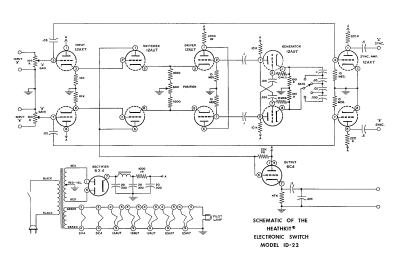
Heathkit wasn’t the only source of these electronic switches. We saw one from Sylvania in a [Mr. Carlson] teardown.
[Jeff] has a look at an old S-3 in another video.
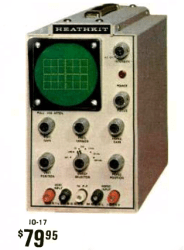
Why Bother?
It is hard to remember just how unaffordable scopes were in the past. In 1969, for example, you could get a single channel 3″ screen scope with a 5 MHz bandwidth that you had to build — from Heathkit, of course, for about $80. Adjusted for inflation, that is over $650 today, and keep in mind, this is for a scope with crazy low specs. It didn’t even have a probe connector. The scope’s inputs were binding posts. You could, however, pay $8 a month for some period of time if you couldn’t find $80 all at one time.
A better scope — still single channel — but with a 5-inch screen and 8 MHz along with things we take for granted today like external sync inputs cost $259 as a kit ($399 ready-to-go; the equivalent of $2,000 and about $3,330, respectively). Keep in mind that the average salary in 1969 was about $500 a month. So a $250 scope was two weeks’ pay — more if you look at take-home pay.
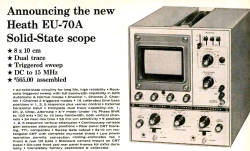
If you wanted a real dual-trace scope from Heathkit, you had to wait for 1971. The EU-70A cost $565 and was all solid-state (except, of course, for the CRT). It had a relatively tiny screen (about 4″x3″) and a 15 MHz bandwidth. It supported both alt and chop modes. You didn’t even have to build it! In 1981, a 15 MHz dual-trace Tektronix T922 retailed for $1,090! Depending on the year, you could get a 10 MHz scope from a brand like B+K, Leader, Eico, or Conar for a little less.
In Operation
[KB9RLW] has a good video about the ID-4101 in use that you can see below. Granted, since his Dad’s old scope blew up, he hooked it to a modern scope, but you can still see how it worked.
DIY
There were plenty of designs for similar adapters published. [Leslie Solomon] of Popular Electronics fame used four standard CMOS ICs to display four traces simultaneously. The schematic below doesn’t show the trigger generation, which required a 4009 or a transistor.
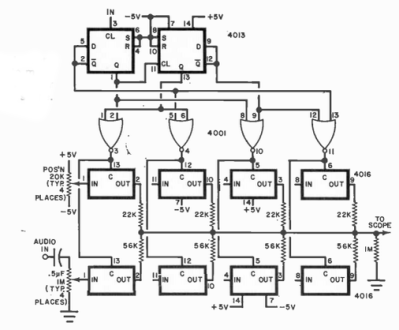
When you think of a $60 scope these days, you might think it isn’t very good, but consider what $60 bought in 1969, and you’ll appreciate the cheap scope of today. If you want to practice your scope abilities, dust off an Arduino and check out this trainer from [Bald Engineer].

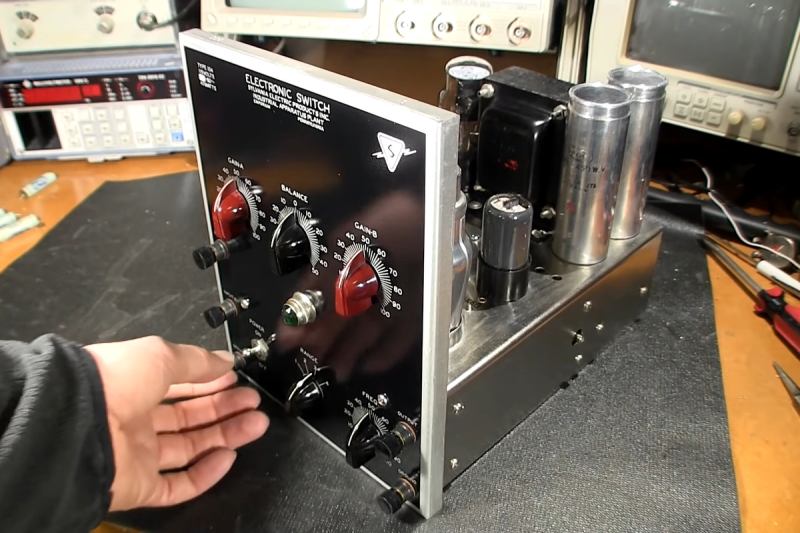














I have a 5″ 8Mhz Heathkit scope. How many internets do I get?
If no one here can answer, there is a company in California that searches the netwebs for information called The Googler. I’ve never used their services myself but I’ve heard they are fast and reliable. I believe the usual method of sending your query along with a self-addressed stamped envelope will work just fine. I don’t have the address but you can ask your local telephone operator to patch you through to the operator in San Jose, and ask if they can provide it. If they can’t, then have them connect you to the SJ Chamber of Commerce. They should be able to provide it for you.
It really is mind-boggling to me how inexpensive tech things are today. I have two 40-50 year old Tek scopes that work fine and cost about what a compact car would cost when new. I paid about 200 (working) and 100 (not working) seven years ago for them. the non-working one cost me $15 to fix.
I just got my first Tek TDS210 the other day as a semi functioning unit. I got the expansion module for the back the other day, the MM with the USB port instead of all the other style ports. I have a new LCD coming for it also. I can’t wait to get this back in working order. I never learned how to use a scope proficiently but hope to learn something with this new/old repaired upgraded unit. Even though it’s only a 60mhz unit, I would have liked to get my hands on a 220 for about what I have in this 210 but at that, would like have to invest more in to get it up to near new condition. I’ve scoped out some like the Hantech but those units are a bit intimidating to me to get up and running with all the software included these days. I watched a Youtube the other day of some guy doing a review and even he was having issues getting it figured out. For a guy like in up in age just getting into Ham radio, it’s daunting.
I have two Picoscopes from Pico Technologies. Th software is easy and intuitive if you’ve ever used a ‘scope before. Probably not too bad if you’re learning either. They’re nice and portable, and you can use them with your laptop when away from your normal bench.
The TDS210 can be told it is a TDS200 with a few GPIB commmands, as long as you then immediately calibrate it to make it remember…
…..TDS210 told it is a TDS220….
[Edit button please!]
From my perspective, a good scope has cost about as much as a reasonable new car since the 1960’s, and still does today. It’s just wow can a good scope now do a lot of amazing stuff. We just got a decent Rohde & Schwarz 3ghz scope, and it was about $40K. It’s pretty easy to spend a good fraction of a million dollars on a really nice scope. I’ve a friend who works for Keysight and I think I remember him showing off a $350K scope recently.
Why always the money thinking (is this an English/American thing) in the comments ? 😕 Money isn’t everything in life, I’d say. Neither is the job, it’s temporarily. To me, it’s friends, hobby, family that matters..
Anyway, the built quality of those old tanks is something that can’t be bought these days. I don’t want to miss my antique equipment. I don’t want to trade my CRTs or analog instruments for LCDs.
I haven’t had a scope of my own since the early 80’s and at the time, I never did get very good with it. I have had access to an automotive scope since those days for a brief window and fortunately I got pretty good at using that piece to diagnose troubles many people would miss in their work. I just recently managed to acquire a 20 some year old Tektronix TDS210 that had issues with the screen, LCD burn. Fortunately parts or should I say replacement used circuit boards are readily available online for this model, however it’s big brother, the 220 or 224 don’t seem to be as plentiful. There seems to be a big supply of replacement screens as well. From what I have watched on Youtube, opinions and reviews of these seem to be a bit negatively biased but for me, that scope I had in the 80’s from memory recall, very little of that, this TDS210 would be so much superior to the B&K of back then which I got to service TV’s right out of school with no OJT which didn’t help me in my advancement in electronics, so I went back to auto repair as I had a better grasp of at the time. I’m very anxious to get my semi functional dual trace 60mHz unit working so I can use it with my new found hobby, Ham radio. At this late stage of life I will never catch up in this field, but at least I have something to piddle with. Many times during those days of early experimentation and education in electronics, I wanted to convert a CRT TV to a scope and read lots of Popular Electronics from days back before I went to school for it. My Uncle was a tech for Zerox and a former Army communications tech but he lived so far away from me we seldom got to see each other, when he did come visit, he usually had some Heathkit project he would bring me so we could work on stuff together. There was never enough time for that as far as I was concerned. Sadly I lost him permanently at a very early age of 37 for him, I was still in high school and 17 when he had a massive heart attach and all my dreams and plans for a future based on his plans for me along with my grandfathers plans died with him. Oh how I long for a new world order as per what is promises mankind in the Bible. Re united with all our families and eternal life to live, love and learn.
One addition to otherwise nice article. Kids that only used digital scopes probably don’t understand why there were two different approaches to switching between channels, alternation and chopping. Alternating between two signals is better for high frequency signals. If you alternate while using slow time base, alternating becomes visible. On the other hand, chopping signal is better for low frequency signals. If you use too fast time base, then chopping becomes visible. So, both methods are compromises. Today we have digital scopes with multiple ADCs, so we don’t have to think about this.
I was lucky enough to score a tektronix 485 a year ago for $100 that was in decent working order, and after cleaning some contacts and running a calibration procedure from the repair manual to fix a trigger issue it functions perfectly. It has buttons for alt and chop modes, which is handy for slow signals (slow enough to see the alt actually alternate sweeps). Just make sure to go back to alt for faster work. I once spent nearly an hour looking for the source of a 10khz square wave signal on top of my circuit output before I realized I’d left it on chop :)
Yes, I can recall the alt/chop. I could not remember if there was an option to make it automatic or I always had to select. I think the college had a few very high end Tek scopes from Boeing Surplus, which was only about 40 minutes away and an incredible source of materials, tools, and instrumentation. I think most HaD readers would go into shock if they had been there when Boeing Research was shut down. There really were no hobbyists to buy items and a few universities that might, so things like a time-of-flight mass spectrometer the size of a car, along with the vacuum pumps and high speed scopes with Polaroid cameras (4×5 3000 speed pos/neg film by the case as well) were being sold by the pound.
Most hobbyists had AC coupled scopes until the seventies. Wouldn’t that make these harder?
ICs made these much more common. Lots of projects in the seventies, but logic made these more useful.
I even remember some complete DC scope projects in the magazines, maybe with dual trace built in.
What about separation transformers, didn’t labs have those? I seriously don’t know. Not my country/generation. Would be interesting to know, however. Especially in those times with bad power lines. The USA, or so I heard as an European, were on 3rd world level when it comes to power grids. Maybe 4th world, too, if there was a lower level. Anyway, a stable power source as provided by separation transformers would surely have been good for the labs. And RCDs, too, I think.
“Most hobbyists had AC coupled scopes until the seventies. Wouldn’t that make these harder?”
I’ve asked my father about this matter, turns out he too built oscilloscopes from scratch at some point in these days and apparently used DC. Also by using the increasingly becoming popular semiconductors for stabilization/rectifying, as you said. 🙂
We are kinda spoiled, yes. I have a low-bandwidth dual-trace oscilloscope built into my modular synth, and putting that together cost less than $80 or so, albeit with the usual hobbyist amortization technique of buying parts over a period of years. (It’s one of those XProtolab oscilloscope-on-a-DIP modules that I had PCBs made for, to mount it in the case with in- and thru-jacks; it’s mostly a visualizer on any given day, but it’s been useful for calibration and such.)
Early in the video he states there was not literature available for the 2 channel switch, I find that hard to believe since Sylvania had to had a patent on this likely. Somewhere there is a schematic and text recorded on it. It’s just a matte of finding it. And given the expanse of data being input to the internet, if it’s not already there, one day it will be. Now if someone is or has done a restoration on one of these boxes, they should make a manual and upload it to the WWW. Now that there is a working restored model, it would be pretty simple to do this.
I remember when the Holy Grail of ‘scopes was called dual BEAM. The CRT’s actually had two sets of horizontal deflector plates and, as the name implies, two electron beams. They also had two timebases so the two beams could be sweeping at different rates if desired. It was pretty much two oscilloscopes sharing one display. I think the military contractor I worked for fresh out of electronics school had one, but I don’t think I ever used it.
That reminds me of analog storage oscilloscopes and spectrum analyzers. The traces were stored in the CRT itself, and became fatter and less distinct with time in a process we called ‘blooming’. And trace capture? Well, that was a film camera that fastened to the hood of the display.
We have indeed come a long way…
The storage o-scopes had additional electron guns (called flood guns) which “flooded” the CRT screen and allowed activated phosphors to remain lit.
As you mentioned, the traces grew fatter as phosphors near the activated ones also lit up.
1L5 tektronix audio spectrum analyzer with long persistence violet phosphorus CRT. It has a linear frequency (not log) display. Used it with a Hewlett Packard audio distortion analyzer. The HP had a noise and distortion output so when doing design work not only did you know what level of distortion you have you also knew if it was hum, wideband, harmonic, etc. It was amazing how many times simply adding or changing ground points could result in lowered harmonic (not hum) components. Everything totally analog. Not a fast Fourier transform to be found anywhere.
I feel chagrin in the fact that I can recognize Mr Carlson’s bench in a photo faster than my own.
“The ID-22 used 11 tubes and a rectifier.”
Um…not quite. If you look closely, you’ll see that five of the tubes in the schematic are dual triodes (two 12AX7s and three 12AU7s). Add the rectifier (6X4) and output driver (6C4), that’s a total of seven vacuum tubes.
That small technicality aside, yeah, the ID-22 is a pretty cool piece of gear to have around, especially when you have ‘scopes of the same vintage with only one channel. Just don’t expect any bandwidth miracles. :)
I remember having a scope in the 1980s. It cost me the equivalent of about 700 (1980) dollars and it was 20 MHz. I was very proud of it because it had twice the bandwidth that the oscilloscopes at my high school had.
Yes I agree that it’s amazing how much cheaper you can get technology nowadays that works even better than that, but on the other hand I’m also concerned that there’s probably no high school anymore that teaches kids about how to use a scope anymore.
” that there’s probably no high school anymore that teaches kids about how to use a scope anymore.”
They’re probably too worried about kids using a rifle scope.
Not to mention something with a CRT. :-D
“Yes I agree that it’s amazing how much cheaper you can get technology nowadays that works even better than that,”
I beg to differ. The Voyager probes were built using 1970s tech and are still operating. Despite not being designed for this purpose.
1970s/early 1980s tech is timeless, I think. It simply lasts and inspires by its” simplicity” (by today’s standards).
Saying that something improves is subjective absolutely however, maybe. It depends on the demands and definitions we apply to it.
Popular Electronics, July 1991, page 59, “Build the Quad-Tracer”
This one multiplexes a scope four ways!
“It is hard to remember just how unaffordable scopes were in the past. In 1969, for example, you could get a single channel 3″ screen scope with a 5 MHz bandwidth that you had to build — from Heathkit, of course, for about $80. Adjusted for inflation, that is over $650 today, and keep in mind, this is for a scope with crazy low specs. ”
Really? 5 Mhz covered the whole AF band up to/including 80 MHz amateur band without conversion! That’s not bad! The amateur band goes from 3,5 to 3,8 or 4 MHz..
Also, 5 MHz covers the bandwidth of 2m band (144,500 146 or 148 MHz). All it needs is tapping the IF (intermediate frequency) on a receiver.
Really, 5 Mhz are okay as a base line setup, I think. That being said, 5 MHz isn’t the maximum range of such scopes, it’s merely the maximum at a given accuracy. The scope will go a bit higher, in practice.
Really, I’m not an oldtimer by any means. But that ancient 5 MHz scope from Heathkit that I have is still fine for all my basic needs.
I was lucky to have a Tek 555 50Mhz scope given to me 20 years ago…when it
died I broke down and got a Siglent 50Mhz for ~$239(new). Can’t say a bad word
about the Siglent. At least from the homebrew/amateur prospective.
The Siglent is ALOT more portable!!!! haha
EDIT—
“I was lucky to have a Tek 555 50Mhz”
Seems I got the model wrong. It was a Tek and 50Mhz….That I do remember.
But a search of that model # is NOT the one I had?!?
It was a DAMN NICE scope. All the bells and whistles.
Hell, the probes may have cost almost as much as my Siglent!! haha
Found it—- It was a model 455. Again, nice scope. Way above
my pay grade at the time.